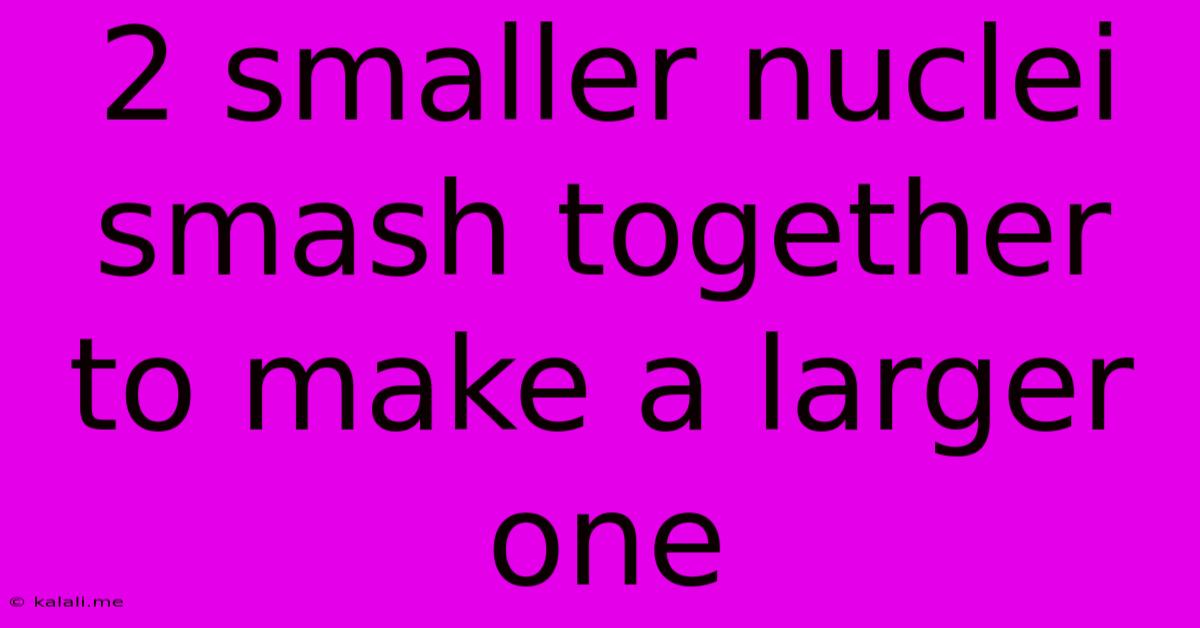2 Smaller Nuclei Smash Together To Make A Larger One
Kalali
May 23, 2025 · 3 min read

Table of Contents
2 Smaller Nuclei Smash Together to Make a Larger One: Nuclear Fusion Explained
Meta Description: This article explores nuclear fusion, the process where two smaller atomic nuclei combine to form a larger nucleus, releasing immense energy. We'll delve into the science behind it, its applications, and its potential as a clean energy source.
Nuclear fusion, the process where two smaller atomic nuclei combine to form a larger nucleus, is a powerful force shaping our universe. From the sun's blazing inferno to the potential future of clean energy on Earth, understanding this process is crucial. This article will explore the mechanics of nuclear fusion, its significance, and the challenges in harnessing its power.
The Science Behind Fusion
At the heart of fusion lies the strong nuclear force, one of the four fundamental forces of nature. This force, acting at incredibly short distances, overcomes the electrostatic repulsion between positively charged protons within the nuclei. When two light nuclei, like isotopes of hydrogen (deuterium and tritium), get close enough, the strong nuclear force takes over, binding them together to create a heavier nucleus, typically helium. This process releases a tremendous amount of energy – far more than nuclear fission, which involves splitting a large nucleus.
The energy released stems from the difference in mass between the original nuclei and the resulting nucleus. This mass difference, according to Einstein's famous equation, E=mc², is converted into energy. This is what powers stars, including our own Sun.
Fusion Reactions: Examples and Implications
Several fusion reactions are possible, each with varying energy outputs and requirements. One prominent example is the deuterium-tritium reaction:
²H + ³H → ⁴He + n + 17.6 MeV
Here, deuterium (²H) and tritium (³H), isotopes of hydrogen, fuse to form helium (⁴He), a neutron (n), and release 17.6 megaelectronvolts (MeV) of energy. This reaction is particularly attractive because it requires relatively low temperatures and pressures compared to other fusion reactions.
The implications of controlled nuclear fusion are vast. It promises a virtually inexhaustible source of clean energy, free from the greenhouse gas emissions associated with fossil fuels and the radioactive waste associated with fission.
Challenges in Achieving Controlled Fusion
Despite its potential, harnessing fusion for practical energy production faces significant technological hurdles. The immense heat and pressure required to overcome the electrostatic repulsion between nuclei necessitate sophisticated containment systems. Currently, scientists are pursuing two main approaches:
-
Magnetic Confinement: This method uses powerful magnetic fields to confine and heat a plasma (a superheated state of matter where electrons are stripped from atoms) to fusion temperatures. The International Thermonuclear Experimental Reactor (ITER) is a prime example of this approach.
-
Inertial Confinement: This involves using powerful lasers or particle beams to implode tiny fuel pellets, compressing and heating them to fusion conditions. National Ignition Facility (NIF) is a leading research facility using this method.
The Future of Fusion Energy
While controlled fusion remains a significant technological challenge, advancements in plasma physics, materials science, and laser technology are steadily bringing us closer to practical fusion reactors. The potential rewards are enormous: a clean, safe, and abundant energy source that could revolutionize global energy production and mitigate climate change. Significant research and development efforts are underway globally, paving the way for a future powered by the same process that fuels the stars. Continued breakthroughs in plasma physics and materials science are crucial for overcoming the remaining hurdles and unlocking the boundless potential of fusion energy. The successful implementation of fusion power would represent a monumental achievement, fundamentally altering our energy landscape and potentially shaping a sustainable future for generations to come.
Latest Posts
Latest Posts
-
Salesforce List View Button Not Showing
May 23, 2025
-
Using Ordinal Measures In Multiple Regression
May 23, 2025
-
Can Parent Give You Referral Company
May 23, 2025
-
Salesforce Vf Render As Pdf Table Css
May 23, 2025
-
The Grammatical Joke That Is Wittgensteins Tractus
May 23, 2025
Related Post
Thank you for visiting our website which covers about 2 Smaller Nuclei Smash Together To Make A Larger One . We hope the information provided has been useful to you. Feel free to contact us if you have any questions or need further assistance. See you next time and don't miss to bookmark.